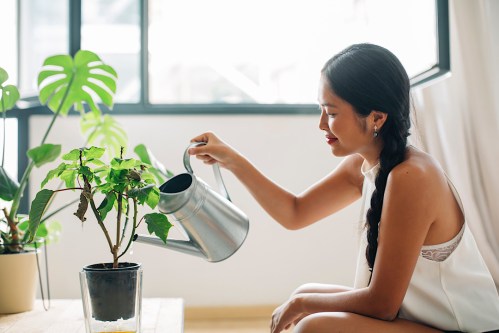Our editors independently select these products. Making a purchase through our links may earn Well+Good a commission
While knowing how often to water your plants tends to be top of mind for any green thumb, an equally important step you don’t want to skip is fertilizing them. Plant fertilizer is a material that is used to supplement the nutrient levels in the soil to help plants grow more vigorously. It typically comes from natural sources such as compost, manure, bone meal, blood meal, and fish emulsion, or from synthetic options such as chemical fertilizers. Another source you can add to that list? Urine. Yes, you can use pee on plants.
Experts in This Article
It may sound a little weird or even gross, but urine can be a good fertilizer when properly prepared (more on that below—no, you can’t just pop a squat over your pots) because it contains some of the most-needed nutrients, like phosphorus, potassium, and nitrogen, a byproduct of eating protein, that plants need to thrive. In fact, the United Nations finds that there’s enough phosphorus, potassium, and nitrogen in the world’s wastewater (aka pee) to replace 13.4 percent of global fertilizer needs.
“You can do this at home and save on the cost that would have been used to buy fertilizers,” says professional gardener Miguel Palma, owner of the gardening advice site Jardin Tienda. Plant fertilizer can range in price from a few dollars to a few hundred dollars, depending on the amount you need, so while money isn’t the only factor to consider here, it can certainly add up.
Plus, why pay for something you can get for free? The same nitrogen, phosphorus, and potassium found in your urine are the three basic plant nutrients in most commonly used fertilizers, according to the U.S. Environmental Protection Agency. Urine also contains trace amounts of zinc, which is another micronutrient found in some fertilizers (not all) that the EPA says plants also need to grow. So pee is a solid substitute for store-bought fertilizers with the added bonus of already possessing these nutrients in a soluble form that’s easy for plants to absorb.
You can urine as frequently as you would any other type of plant food (or fertilizer), which will vary depending on season and type of plant. So do your homework on your specific plant or speak with a specialist at your local nursery or plant shop who can offer you recommendations based on whether your plant is indoors or outdoors, potted or not, as well as what phase of its growth cycle it’s in, all factors to keep in mind.
What to know about peeing on your plants
Palma says that the first thing to note when intending to use human urine as fertilizer is that the urine is too concentrated. “It should be diluted before application,” he says. Otherwise, it can burn the leaves or kill off microorganisms that you need in the soil.
If you’re worried about the smell, it should dissipate pretty quickly, Palma says, or you can add some vinegar to the container while it’s empty to counteract any odors.
Another factor to consider, no matter what form of fertilizer you’re using, is the temperature of the soil, which should be at least 50º F for cold-season crops outside and 60–70º F for warm-season plants, to make sure the plants can properly absorb the nutrients, according to horticulturalists at Oregon State University. This is really only a factor to consider with outdoor plants, but still something to keep in mind.
Urine also has salts in it, and salt is not great for your plants. As long as you water well between pee applications, the salts will be diluted and you won’t have a problem. If you start to see scorched leaves, wilting, or a white crust on the soil, your salt levels are too high and you need to dilute the urine more and water with more pure water between fertilizations.
The drawbacks of using urine as plant fertilizer
Using your own urine as fertilizer sounds like a free, relatively simple way to ensure your plants get the nutrients they need to stay healthy, and it is. But there are a few drawbacks to using pee on plants you should also consider. For starters, urine is high in nitrogen (according to the journal Nutrition Research and Practice, the average concentration of nitrogen in human urine is around 0.14g/L), which can cause burning and other damage to plants if it is not used in the correct amounts. Additionally, its odor can repel beneficial insects like bees and butterflies if you’re using it outdoors, and it can attract animals like rats, which can cause additional problems.
There are ways to mitigate these issues; however, and depending on where you live and whether your plants are indoors or out, it may still be worth exploring using your own urine as fertilizer.
How to use pee on plants as a fertilizer
Step 1: Collect your urine
To do this, you’ll need a cup (if you’ve every given a urine sample at the doctor’s it’s the same idea). Pee into your cup and then transfer your urine to your watering can.
Step 2: Prepare your pee
As Palma mentioned, pee is too concentrated to pour directly onto plants, so you need to dilute it first. Dilute your pee with five to 10 parts water using the same cup your collected your pee in to help . The ratio doesn’t have to be exact, you can just eyeball it, Palma says.
Step 3: Sprinkle your soil
Just like during a normal watering session, you don’t want to douse your plant’s leaves with fertilizer; instead, aim to saturate the soil. Palma says it works best when applied to actively growing plants before they grow fruit or seeds.
Is using pee on your plants safe?
Just like with any fertilizer, when using pee as plant food, you want to be mindful to handle your urine carefully. Wash your hands after handling urine and wash your fruit and vegetables before eating them—two things you should already be doing anyway. If you’re fertilizing produce in your garden, the Rich Earth Institute, which researches the safety of using urine on crops for eating and is using donated human urine to make commercial fertilizer for sustainable farming, recommends waiting at least a month after fertilizing to eat anything you’ve grown (regardless of type of plant food). But this shouldn’t be an issue in practice since, as Palma points out, the time to fertilize your soil is well before harvest season.
Sign Up for Our Daily Newsletter
Get all the latest in wellness, trends, food, fitness, beauty, and more delivered right to your inbox.
Got it, you've been added to our email list.











